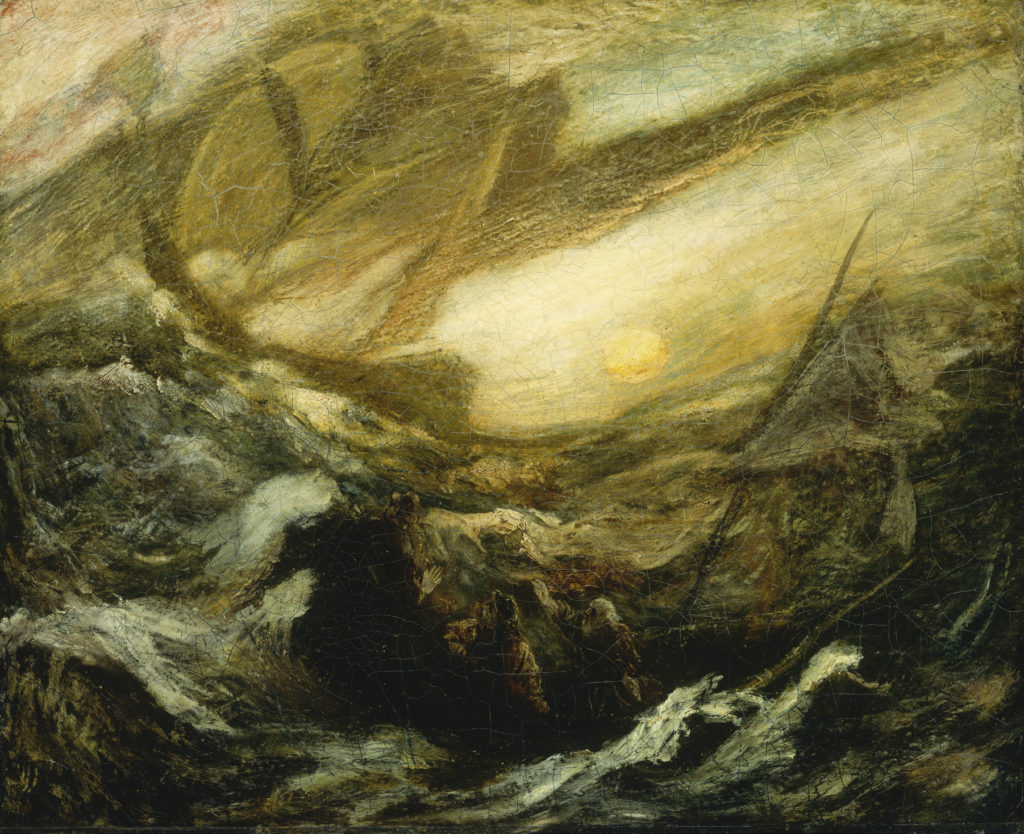In one of his only published comments on art, a 1905 treatise titled “Paragraphs from the Studio of a Recluse,” the American painter Albert Pinkham Ryder (1847–1917) wrote that “the artist needs but a roof, a crust of bread, and his easel, and all the rest God gives him in abundance.” Ryder continued: “He must live to paint and not paint to live. He cannot be a good fellow; he is rarely a wealthy man, and upon the potboiler is inscribed the epitaph of his art.” A quarter-century later, Virginia Woolf struck a similar note when she famously argued that a woman wanting to write fiction requires just two things: enough money to get by on, and a “room of one’s own.” In context, the two essays aren’t at all alike: Woolf’s broader argument is about making space for women in the literary tradition, whereas Ryder offers a personal defense of thrift and simplicity. Shared by both, however, is the understanding that isolation is a positive and essential—perhaps the essential—condition for artistic creation. A room “of one’s own,” that is—the studio of a recluse.
The sentiment isn’t widely accepted today, to say the least. Within the art world, the rise of Masters in Fine Arts programs whose symbolic center is “the group critique”—a communal evaluation of how an artist’s work fits within the shared “theoretical discourse”—has helped to spur a dramatic change in the way artists view themselves in relation to society. As Gary Alan Fine writes in his 2018 ethnographic study of these programs, Talking Art: The Culture of Practice and the Practice of Culture in MFA Education,
Today artists increasingly create for each other, hoping for approval from those within the guild, and they must explain what they intend. Once artists were mute; today they talk and write as well as create. The art world is an occupational community, like sociology, medicine, or law. Now embedded within universities and art schools, art increasingly constitutes an academic discipline.
The romantic image of the lonely visionary toiling away in a bedraggled studio is consistently disparaged as foolish myth. Fine records a professor admonishing a student with the help of John Donne: “The biggest weakness is that you are thinking of yourself as a single artist. No one is an island in themselves.” At another school, a student proclaims that “the individual artist is not something I believe in”—to which his professor fires back, “does anyone? . . . There’s nobody who thinks of an artist like that anymore.”
In a sense, these academicians have a point. The idea that people are out there making good art in a vacuum rarely holds up upon close inspection, if ever. Even so-called “outsider artists” usually turn out to have had more training and more knowledge of other art and artists than is usually acknowledged. Society’s role in fostering artistic achievement can hardly be overstated. Like any human community, artists share ideas and build off one another to reach otherwise unthinkable heights. Competitive drive plays perhaps an even more crucial role, and goes back, at the very least, to the origins of art history: see Pliny the Elder’s famous account of the ancient Greek artists Zeuxis and Parrhasius battling it out in a trompe l’oeil tournament for the title of greatest living painter. In Renaissance Italy and elsewhere, architects, sculptors, and painters strove passionately against one another to win the largest and most glorifying commissions. Michelangelo and Raphael, Borromini and Bernini, Ingres and Delacroix, Turner and Constable, Matisse and Picasso—rivalries have inspired not only legendary historical anecdotes, but also immortal artistic achievements.
Nevertheless, the over-socialization of art presents a chronic risk. Schools designed to teach foundational skills can end up enforcing sterile academicism. A robust patron class might breed commercial decadence. Rabid one-upmanship will often beget mere spectacle. In the mainstream of today’s art world these all are real and present afflictions. But they’re also not new. Were those pictures by Zeuxis and Parrhasius actually good paintings, in addition to being immaculate demonstrations of mimetic technique? The latter, after all, doesn’t imply the former.
Thus, throughout history there have been those who call for the return of a more private, individual, “authentic” aesthetic, one uncorrupted by social influences. In a first century A.D. text titled On the Sublime, the author known as “Longinus” deplores the decay of rhetoric in his day. Begging for a return to a poetic mode of greater simplicity, Longinus argues that the writer hoping to elevate his craft must look inward: “a writer can only learn from art when he is to abandon himself to the direction of his genius.” Fast forward seventeen centuries and Jean-Jacques Rousseau was similarly arguing that artists were better off working alone, beyond the constricting reach of civilization: “so long as they undertook only what a single person could accomplish and confined themselves to such arts as did not require the joint labor of several hands, they lived free, healthy, honest, and happy lives.”
Closer to our own time, the image of the artist in isolation finds perhaps its most vital expression in the more romanticist strains of modern literature: the ostracism of Frankenstein’s monster, Thoreau’s pond-side solitude, the spiritual exile of Stephen Dedalus, the emotional paralysis of J. Alfred Prufrock, the invisibility of Ellison’s narrator. Isolation and loneliness, in their manifold varieties, became productive, advantageous states of mind, enabling the artist to level his denunciation of an increasingly Enlightened, idealist, and industrial modernity. Even Melville’s crew, working and living together in close proximity aboard the cramped and oil-grimed Pequod, were souls apart, refuting both Donne and that unnamed art prof: “They were nearly all Islanders in the Pequod, Isolatoes too, I call such, not acknowledging the common continent of men, but each Isolato living on a separate continent of his own.”
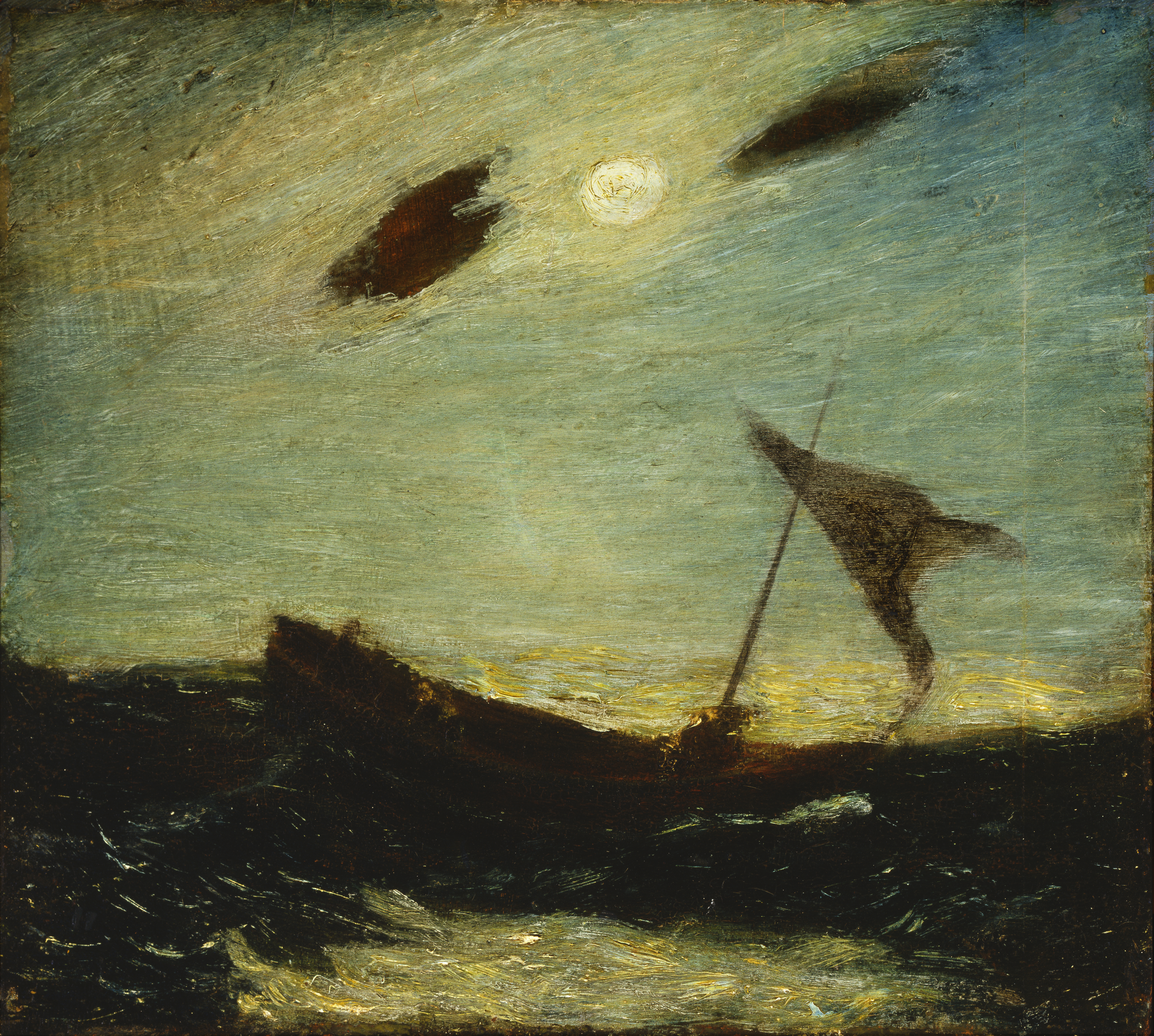
But it is just this modernist belief in the creative powers of the individual soul that has come under fierce attack in our own more nihilistic and totalizing times. It is thus both surprising and encouraging to learn that painters like Albert Pinkham Ryder are garnering new attention from historians and artists alike. This summer, a major monograph on the painter, the first in more than three decades, was published by Rizzoli.1 It was intended to coincide with a significant retrospective exhibition, also the first of its kind since 1990, at the New Bedford Whaling Museum, though unfortunately this was postponed until June 2021 due to the covid-19 outbreak. With color illustrations as well as insightful essays by Christina Connett Brophy, Elizabeth Broun, and William C. Agee that analyze, respectively, Ryder’s historical context, his elusive painterly ideas, and his outsize influence on generations of artists, A Wild Note of Longing: Albert Pinkham Ryder and a Century of American Art offers us the exceedingly welcome chance to reflect on this austere, stirring, and wholeheartedly strange painter.
It has often been said that Ryder was both America’s last great romanticist and her first prophet of modernism. Born in New Bedford in 1847—just four years before the publication of Moby-Dick, whose early chapters take place in the southeastern Massachusetts whaling town—the artist moved with his family to New York City’s Greenwich Village in 1868, where he lived and worked in various small apartments for the rest of his life. By the time he died in 1917, Ryder was the subject of intense veneration among a coterie of early American modernists such as Marsden Hartley, Milton Avery, and Arthur Dove. These three and others looked up to Ryder as a spiritual and aesthetic forefather, and saw him as the fountainhead of a specifically American stream into modern painting. As Hartley recalled first encountering a Ryder in 1909, “when I learned he was from New England the same feeling came over me in the given degree as came out of Emerson’s Essays when they were first given to me—I felt I had read a page of the Bible. . . . The picture has done its work and I was a convert to the field of imagination into which I was born.”
In his own 1905 “Paragraphs,” Ryder assumes a deliberately antisocial and anti-commercial posture, suggesting that, for him, independence of mind and body was a matter of artistic authenticity. Elsewhere in the short essay, which is reproduced in full in the opening pages of the present volume, his obsession with artistic self-reliance verges on the Emersonian:
The artist should not sacrifice his ideals to a landlord and a costly studio. . . . [He] should once and forever emancipate himself from the bondage of appearances and the unpardonable sin of expending on ignoble aims the precious ointment that should serve only to nourish the lamp burning before the tabernacle of the muse.
That Ryder seemed to live by this code, too, undoubtedly contributed to his late-in-life celebrity among the young bohemians of New York’s avant-garde. Certainly, the self-titled “recluse” was eccentric. He never married and became a notorious slob. Sometime in the mid-1890s he stopped throwing things out of his cramped room in Greenwich Village. One friend recounted that it “was a mass of papers, pasteboard boxes, some with food, others, empty, piled high. . . . He slept on a cot, but not being able to keep it clean he abandoned it and slept on the floor.”
At around the same time he started to hoard his paintings as well, endlessly adjusting, re-touching, re-glazing, and re-varnishing old pictures in lieu of beginning new ones. This was bad for business, to say the least. Many would-be buyers recalled eagerly purchasing a painting still on the easel, only to wait years before Ryder would let the thing out of his studio. One exasperated collector demanded that Ryder hand over a “finished” work; the artist responded by raking a hot comb across the picture’s surface, bringing all parties involved back to square one. Another was more resigned to the interminable process, informing Ryder that he left directions in his will to have the funeral procession stop by the studio to pick up the long-awaited work. Even then, “Not unless ’twas done” was Ryder’s reply.
Nevertheless, the image of Ryder as a world-renouncing “outsider” has been greatly exaggerated. Contrary to claims that he was a self-taught naif, the artist had been trained in academic draughtsmanship, was knowledgeable of art history, and kept close ties with fellow painters. His turn towards extreme seclusion happened only late in life. In addition to the pastoral landscapes and maritime nocturnes for which he’s best known, Ryder painted allegorical scenes from the Bible, Greek mythology, history, Shakespeare, Wagner, and more. He read the Romantics—Byron, Coleridge, Keats, Poe—and wrote poetry himself. (The title of the book, “A Wild Note of Longing,” comes from a line of Ryder’s own verse.) And though he never became rich, Pinky (as he was known to friends—“The Reverend” was another moniker) had loyal dealers through most of his working life, as well as a small but energetic group of collectors that sustained his painterly ambitions and tolerated his vexing habits.
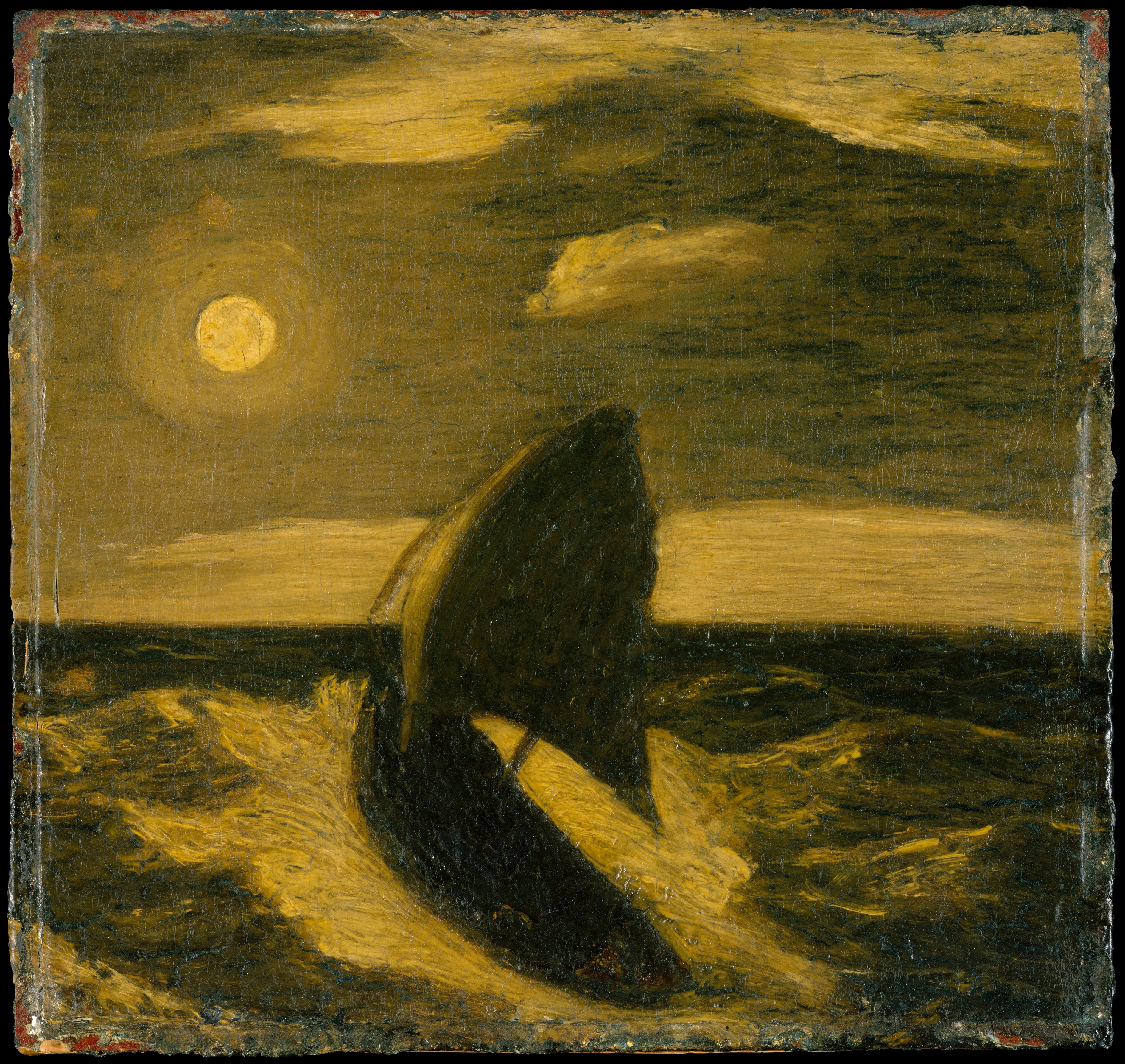
But putting aside such extraneous biographical niceties, it is Ryder’s formal solitude, the intensely lonely nature of the paintings themselves, that remains crucial to us today. Indeed, Ryder’s private visions, fired in the kiln of imagination and memory, could not have been more inimical to the prevailing taste of his own time. One of the only works by the painter on regular public view in New York (much of his œuvre can be found in Washington, D.C., at either the Phillips Collection or the Smithsonian American Art Museum) is the Metropolitan Museum’s Toilers of the Sea (ca. 1880–85), a nighttime maritime scene in which a lone small boat crests a wave before a silent horizon in the distance. Tucked away in a corner of the Met’s American Wing, the tiny painting—just about a foot tall and wide—is accessible only by passing the expansive and expansionist landscapes of Hudson River School painters like Thomas Cole, Albert Bierstadt, Frederic Edwin Church, and William Bradford. As Brophy notes in her introductory essay, these latter painters’ works, glistening with gold and filled with flawlessly rendered detail, traveled the country as public spectacles, viewers dropping coins to have curtains drawn back in a flourish, revealing the images for short periods of privileged gazing.
It’s hard to believe that anyone would pay for such an encounter with Ryder’s Toilers. On first glance, the painting seems modest and mute, even clumsy. In his endless quest to transform paint into something utterly new (“less painty-looking than any man before me,” he once said), Ryder was prone to brazenly mixing and matching his paints with wildly different mediums—introducing such alien materials as dirt, tar, wax, and even tobacco juice—as he built up his surfaces over the months and years. This kind of maniacal studio experimentation has caused many of his pictures to disfigure irreparably, almost before our very eyes, as fast-drying outer surfaces harden over under-layers that remain viscous and wet, flowing like lava and crackling the image into islands of slowly sagging pigment.
Though not quite as mangled as some of the grisliest examples, Toilers has cracked and deteriorated to a degree, its surface acting almost like a barrier to entry, the strange and knobby textures of time pulling the eye from the image within. Only by sustained contemplation can you hope to unlock the door onto Ryder’s private world. Spend enough time with it, though, and secrets do unfold. Despite its discoloration you begin to notice extremely subtle variations in tone, and gem-like hues—orange, red, green, blue—begin to glow underneath the pale yellows and blacks of its monochromatic drawing. As you trace the wavering contours of its interlocking forms you begin to feel its compact rhythms, its contrapuntal masses taking on a shifting and palpable weight, whether boat or moon or wave or cloud. Lost in the picture’s internal movements, you’ve now closed the door behind you, shut off from the outside world. This small and strange panel is yours, and yours alone.
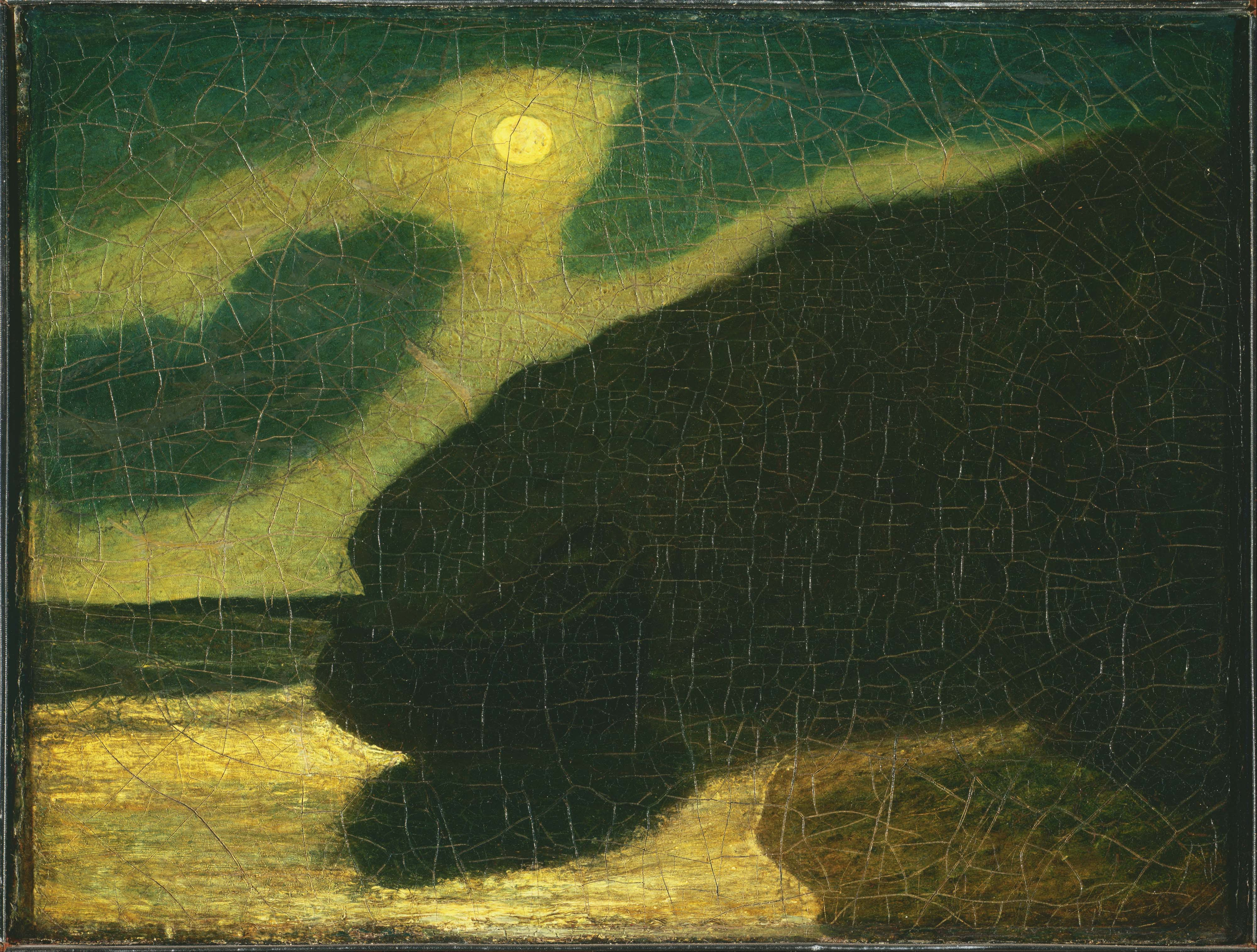
In pictures such as the Phillips Collection’s Moonlit Cove (ca. 1880–90), Ryder goes further, simplifying to the extreme, restricting himself to only a handful of ostensibly flat forms, the largest a monumental, black, glob-like mass within which are the impossibly faint suggestions of a cove, a boat, and their shadows. Almost entirely devoid of discernible subjects, such paintings thrilled and inspired Ryder’s avant-garde champions in the early twentieth century, earning him pride of place at the center of their landmark Armory Show of 1913. Indeed, the sixty-six-year-old painter was the lone American to be included in that exhibition’s section of “Old Masters.” But to regard Ryder as an almost-abstractionist, someone who would have dropped content completely if only he had been born a few decades later, is to miss the essential figurative nature of his vision. Indeed, with Moonlit Cove, despite the sturdy decoration of its arabesque contours, it is precisely the more numinous qualities of atmosphere, space, and absorptive moonlight that give the picture its enduring energies.
Jonah (ca. 1885–95, Smithsonian American Art Museum), perhaps Ryder’s greatest masterpiece, kicks these energies into maximalist overdrive. Amid a whorling maelstrom of crashing waves and devouring black depths, we find the Hebrew prophet cast overboard, abandoned by his shipmates, flailing and gasping for air. The treacherous black whale eyes Jonah hungrily from the shadows to the right, while above, emerging through the amber light of parting clouds, is the divine image of God in benediction, a force of celestial calm amid the general confusion. The picture lands somewhere between Turner’s Slave Ship (1840) and William Blake’s mystical monotypes, but its painterly language is wholly Ryder’s own. None of it looks sensibly “real” in the way that a Bierstadt or Bradford wows us with impeccable detail and crystal-clear naturalism, yet somehow the chaos feels frighteningly plausible. As Ryder himself once said, “What avails a storm cloud accurate in form and color if the storm is not therein?”
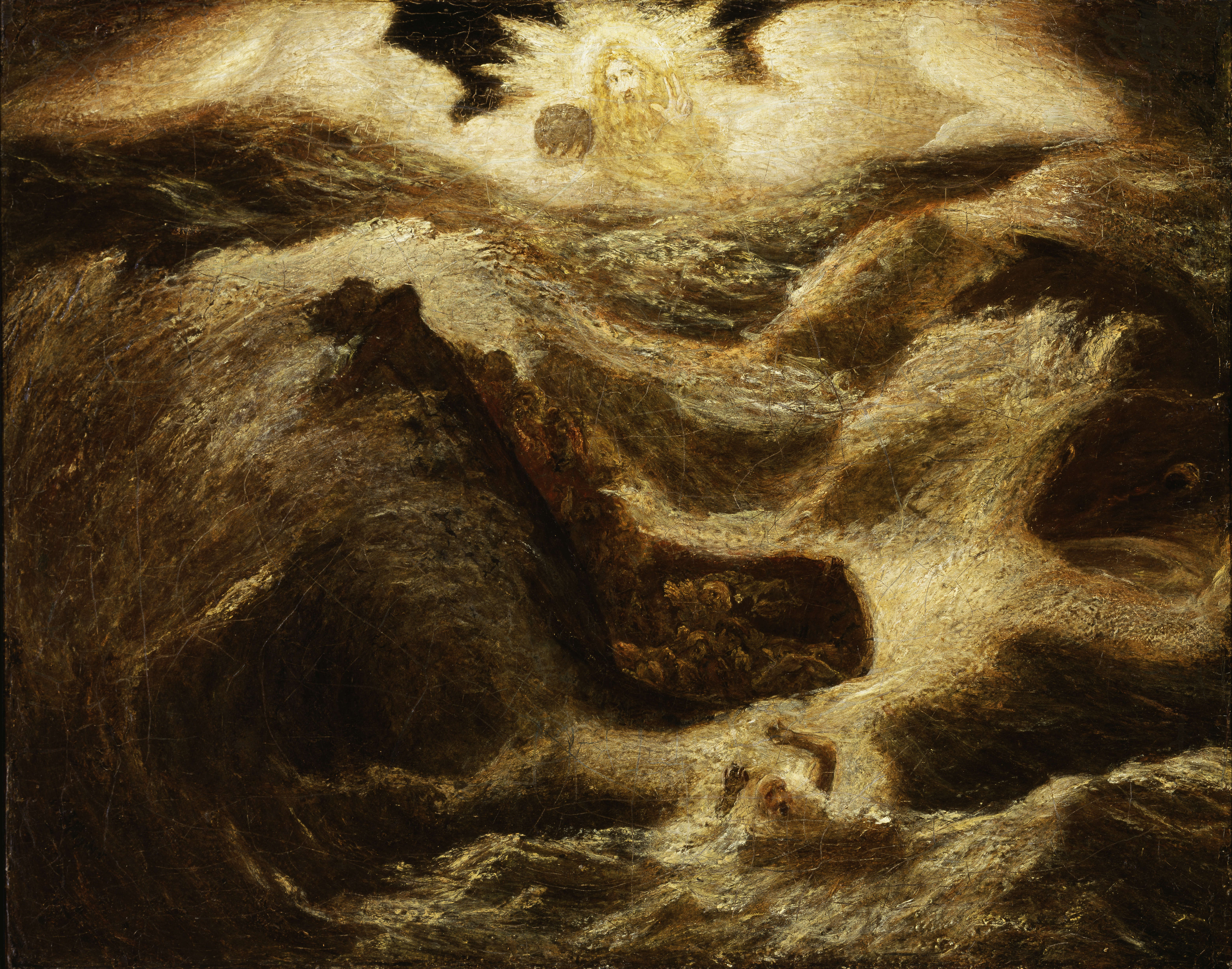
Given the cetaceous subject matter, another glance towards Melville and his own great whale is inevitable. Struggling to make sense of the tempestuous painting, with its churning gestures and inscrutable textures that are saturated with the mystery of ten years of overpainting, one might even think of that “boggy, soggy, squitchy picture truly, enough to drive a nervous man distracted” that utterly bewitches Ishmael in the dark hallways of New Bedford’s Spouter Inn. But the resemblances run deeper even than subject and style. “Ryder, like Melville, was concerned with the depths, the parts of experience that elude statement, that must be hinted at, approached obliquely, rendered in parables,” Lewis Mumford brilliantly observed back in 1931: “When he chose to portray the loneliness of the soul, he might convey the meaning through a little boat with a torn sail, swallowed by the ocean.”
Is it possible that artists still busy themselves with pursuing such depths, with digging into those “parts of experience that elude statement, that must be hinted at, approached obliquely, rendered in parables”? In his essay on Ryder’s enduring legacy, which concludes the monograph, William C. Agee makes the case that they do—in increasing numbers, and with growing enthusiasm. In this “postmodern” age, anesthetized by technology and obsessed only with style and easy superficialities, Agee’s argument for the painter and his followers reads something like a voice crying out in the wilderness:
For years, much art writing was in the stifling grip of conceptual and theoretical speculation, much of it incomprehensible. That is changing, for art, like life, is real, and must be experienced to be known. A younger generation of artists wholeheartedly embrace such things and speak openly and with passion about Ryder.
There are the well-documented acolytes such as Marsden Hartley, Arthur Dove, Milton Avery, Jackson Pollock, and Mark Rothko, but also less obvious offshoots such as Robert Rauschenberg and even Donald Judd. Moving to the contemporary period we find, among others, Albert York (who died in 2009), Wolf Kahn (who died this March), and diverse living veterans such as Lois Dodd, Katherine Bradford, Sanford Wurmfeld, and John Walker. Younger painters include Alan Prazniak, Peter Shear, and Emily Auchincloss. Against Frank Stella’s claim that “what you see is what you see”—the “God is Dead” moment of romantic painting—these painters look with Ryder for “the reality of forces below the surface,” as perhaps his most vocal champion, the contemporary painter Bill Jensen, has written.
Are there others? I was surprised not to find mention of Jake Berthot, whose dark-toned and closely valued late paintings (he died in 2014) of trees and mountains, with their intriguing surfaces and mysterious translucencies, owe much to Ryder. Enrique Martinez Celaya’s inexplicable and mystical landscape narratives, infused with a Kierkegaardian sense of doubt and foreboding, also relate to Ryder’s poetic sense of solitude. Two exhibitions in New York last month—of Tom Uttech’s dream-like pictures of imagined Northwest woods at Alexandre Gallery, and, at DC Moore, of Eric Aho’s alchemical abstractions based on the hinterland wilderness of northern New England—were yet more evidence that artists are charting interesting, new ground by turning the eye inward.
It’s a bitter irony that a pandemic which has forced entire populations into various positions of physical isolation has also prevented us (for now) from experiencing Ryder’s lonely art in full, and in person—which, of course, it utterly demands. Thankfully, art is long, and just as the artist “must buckle himself with infinite patience,” as Ryder wrote 115 years ago, so must we bide our time in anticipation of the chance to do so.
1 A Wild Note of Longing: Albert Pinkham Ryder and a Century of American Art, by Christina Connett Brophy, Elizabeth Broun, and William C. Agee; Rizzoli Electa, 248 pages, $65. An exhibition of the same name will open at the New Bedford Whaling Museum, Massachusetts, on June 24, 2021, and remain on view through October 31, 2021.
